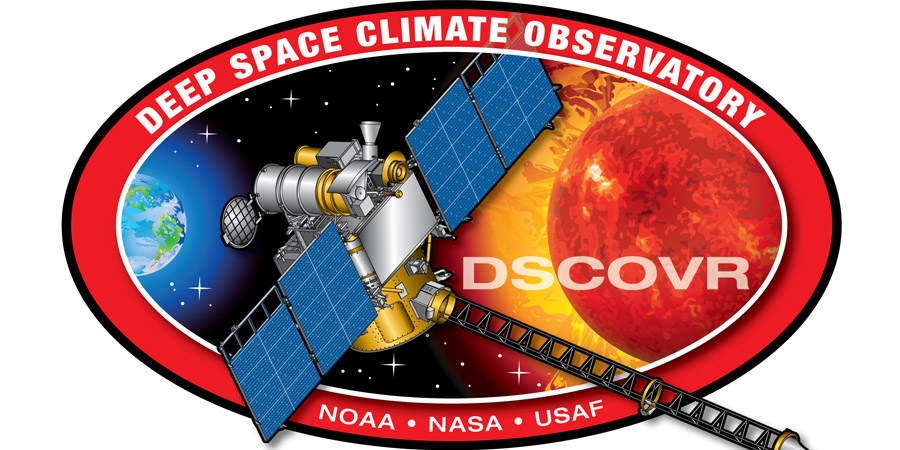Welcome DSCOVR, Very quiet Sun
Thursday, 28 July 2016 16:18 UTC

Welcome DSCOVR! Yesterday at 16:00 UTC, the NOAA SWPC switched from the Advanced Composition Explorer (ACE) to the Deep Space Climate Observatory (DSCOVR) as the primary source of real time solar wind data. Congratulations to the NOAA SWPC for the successful switch over to their first deep space weather satellite.
What does that mean for our visitors? Well, not all that much at the moment actually. We already switched over automatically to the data from DSCOVR when it became available as the primary space weather data source from the NOAA SWPC, yesterday at 16:00 UTC.

Image: DSCOVR is the first space weather satellite operated soley by the NOAA SWPC at the Sun-Earth L1 point.
For the time being, it seems that the NOAA SWPC is still providing real time data from ACE but they announced that they could not guarantee that they will provide real time data from ACE in the future. ACE will continue its mission at the Sun-Earth L1 point and collect data but it will no longer be collected in real time in the future. For the time being, users can still access ACE solar wind and IMF data here on the site by viewing the graphs provided by the NOAA SWPC on this page. All the solar wind and IMF data graphs that we provide will from now on only show DSCOVR data.
The data from ACE's Electron, Proton, and Alpha Monitor (EPAM) particle instrument is also still flowing in like normal and we will continue to provide this service on our website as long as the NOAA SWPC provides real time data from ACE. DSCOVR does not have an instrument comparable to ACE's EPAM instrument so this would be a loss to the space weather community when we no longer recieve real time EPAM data.
Very quiet Sun
Our Sun really crashed back to very quiet levels after the departure of sunspot region 2567 which was the source of no less than seven M-class solar flares between 21 July and 24 July. We are now once again back to very quiet solar activity with the background flux around the A6 class and no numbered sunspot region on the earth-facing solar disk.

Image: our Sun as seen by SDO/HMI at 14:30 UTC 28/07/2016.
During the past 24 hours we only had one solar flare which peaked at... B1.1. Solar activity is expected to remain very low, no significant flaring activity is expected in the days ahead.
Here at Earth we are seeing the effects of a coronal hole solar wind stream. The solar wind density is elevated reaching more than 20p/cm3 at times and the north-south direction of the IMF (Bz) is mostly southward occasionally dipping lower than -5nT. The solar wind speed remains fairly slow but it might be worth keeping your eyes on the data in the hours ahead to see if things improve. Active geomagnetic conditions (Kp4) can not be excluded if conditions improve.
While we have your attention... we also really want to remind you to follow us on Twitter. Space weather might be quiet at the moment but our unique automated alert system is on alert 24/7 and keeps us up to date by posting snappy alerts to our Twitter channel. If there is a space weather event worth knowing about, you will be notified immediately if you follow our Twitter account @_SpaceWeather_
Thank you for reading this article! Did you have any trouble with the technical terms used in this article? Our help section is the place to be where you can find in-depth articles, a FAQ and a list with common abbreviations. Still puzzled? Just post on our forum where we will help you the best we can!
Latest news
Latest forum messages
Support SpaceWeatherLive.com!
A lot of people come to SpaceWeatherLive to follow the Sun's activity or if there is aurora to be seen, but with more traffic comes higher server costs. Consider a donation if you enjoy SpaceWeatherLive so we can keep the website online!

Space weather facts
| Last X-flare | 2025/03/28 | X1.1 |
| Last M-flare | 2025/04/22 | M1.3 |
| Last geomagnetic storm | 2025/04/21 | Kp5+ (G1) |
| Spotless days | |
|---|---|
| Last spotless day | 2022/06/08 |
| Monthly mean Sunspot Number | |
|---|---|
| March 2025 | 134.2 -20.4 |
| April 2025 | 124.6 -9.6 |
| Last 30 days | 121.2 -9.9 |


